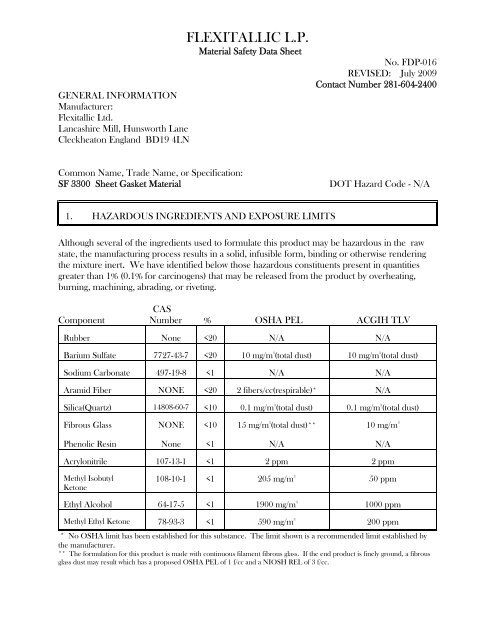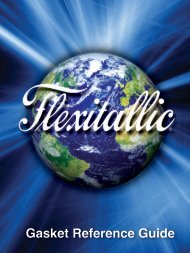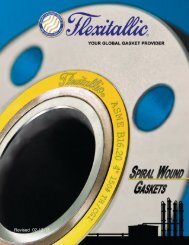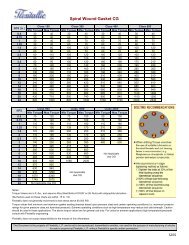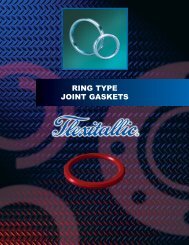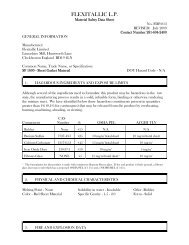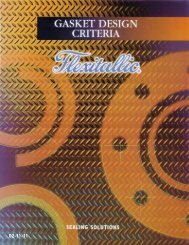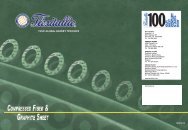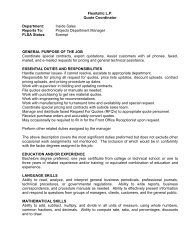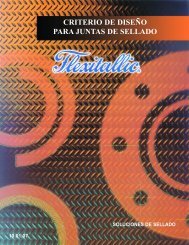SF3300 - The Flexitallic Group
SF3300 - The Flexitallic Group
SF3300 - The Flexitallic Group
Create successful ePaper yourself
Turn your PDF publications into a flip-book with our unique Google optimized e-Paper software.
GENERAL INFORMATION<br />
Manufacturer:<br />
<strong>Flexitallic</strong> Ltd.<br />
Lancashire Mill, Hunsworth Lane<br />
Cleckheaton England BD19 4LN<br />
FLEXITALLIC L.P.<br />
Material Safety Data Sheet<br />
No. FDP-016<br />
REVISED: July 2009<br />
Contact Number 281-604-2400<br />
Common Name, Trade Name, or Specification:<br />
SF 3300 Sheet Gasket Material DOT Hazard Code - N/A<br />
1. HAZARDOUS INGREDIENTS AND EXPOSURE LIMITS<br />
Although several of the ingredients used to formulate this product may be hazardous in the raw<br />
state, the manufacturing process results in a solid, infusible form, binding or otherwise rendering<br />
the mixture inert. We have identified below those hazardous constituents present in quantities<br />
greater than 1% (0.1% for carcinogens) that may be released from the product by overheating,<br />
burning, machining, abrading, or riveting.<br />
CAS<br />
Component Number % OSHA PEL ACGIH TLV<br />
Rubber<br />
Barium Sulfate<br />
Sodium Carbonate<br />
Aramid Fiber<br />
Silica(Quartz)<br />
Fibrous Glass<br />
Phenolic Resin<br />
Acrylonitrile<br />
Methyl Isobutyl<br />
Ketone<br />
Ethyl Alcohol<br />
Methyl Ethyl Ketone<br />
None<br />
7727-43-7<br />
497-19-8<br />
NONE<br />
14808-60-7<br />
NONE<br />
None<br />
107-13-1<br />
108-10-1<br />
64-17-5<br />
78-93-3<br />
2. PHYSICAL AND CHEMICAL CHARACTERISTICS<br />
Melting Point - None Solubility in water - Insoluble Odor -Rubber<br />
Color - Light Yellow Specific Gravity - 1.5 - 2.0 Form - Solid<br />
3. FIRE AND EXPLOSION DATA<br />
Auto-ignition Temperature: This product is inherently flame resistent.<br />
Flammable Limits in Air: % in Air by Volume: LEL: N/A UEL: N/A<br />
Extinguisher Media: Carbon dioxide, chemical, or foam<br />
Special Firefighting Procedure: Material in or near fires should be cooled with a water<br />
spray or fog. A self-contained breathing apparatus, operating in the positive pressure<br />
mode, and full fire fighting protective clothing should be worn for combative fires.<br />
Unusual Fire and Explosion Hazards: <strong>The</strong>rmal decomposition or combustion may<br />
produce dense smoke, oxides of carbon, and low molecular weight organic compounds<br />
whose composition has not been characterized.<br />
4. PHYSICAL HAZARDS AND REACTIVITY DATA<br />
Stability: Stable at normal temperatures and storage conditions<br />
Incompatibility: None<br />
Hazardous Decomposition Products: None<br />
Hazardous Polymerization: Will not polymerize. This product is fully cured in the<br />
manufacturing process.<br />
5. HEALTH HAZARDS<br />
Carcinogenicity:<br />
Phenolic Resin<br />
Acrylonitrile<br />
M.I.B.K<br />
Ethyl Alcohol<br />
M.E.K<br />
Barium Sulfate<br />
Silica(Quartz)<br />
NTP Listed<br />
No<br />
Yes<br />
No<br />
No<br />
No<br />
No<br />
Yes<br />
IARC Listed<br />
No<br />
Yes*<br />
No<br />
No<br />
No<br />
No<br />
Yes**<br />
NIOSH Listed<br />
No<br />
Yes<br />
No<br />
No<br />
No<br />
No<br />
Yes<br />
OSHA Listed<br />
No<br />
Yes<br />
No<br />
No<br />
No<br />
No<br />
No
Carcinogenicity:<br />
Rubber<br />
Sodium Carbonate<br />
Aramid Fibers<br />
Fibrous Glass<br />
NTP Listed<br />
No<br />
No<br />
No<br />
No<br />
IARC Listed<br />
No<br />
No<br />
No<br />
No***<br />
NIOSH Listed<br />
No<br />
No<br />
No<br />
OSHA Listed<br />
* IARC classifies quartz as "probably carcinogenic to humans." (<strong>Group</strong> 2A)<br />
** IARC classifies acrylonitrile as "probably carcinogenic to humans." (<strong>Group</strong> 2A)<br />
*** IARC classifies “continuous filament glass dust” as "not classifiable with respect to human<br />
carcinogenicity." (<strong>Group</strong> 3) IARC and NTP classify “fibrous glass dust” as “possibly carcinogenic to humans.” (<strong>Group</strong><br />
2B)<br />
Symptoms and Effects of Exposure to the Individual Components:<br />
RUBBER (POWDERED)<br />
Inhalation hazards - May cause mild irritation of respiratory tract. Repeated and prolonged inhalation of<br />
dust may lead to a benign pneumoconiosis. This condition may cause some lung function impairment but<br />
is reversible with reduced exposure.<br />
Other hazards - Eyes - may cause mild transient eye irritation.<br />
BARIUM SULFATE<br />
Inhalation hazards - Should be treated as a nuisance dust. Exposure to Barium Sulfate may cause<br />
paroxsymal coughing, wheezing, difficult breathing and upper respiratory tract irritation.<br />
Other hazards - No adverse effects have been reported from ingestion. Eye contact may cause temporary<br />
discomfort and irritation.<br />
SODIUM CARBONATE<br />
Inhalation hazards - moderately toxic by inhalation and subcutaneous routes. Other hazards - Poison by<br />
intraperitoneal route. May irritate eyes and skin on conact.<br />
ARAMID FIBERS<br />
Inhalation hazards - Overexposure to respirable fibers by inhalation may cause mild and temporary upper<br />
respiratory irritation, with discomfort or cough. Based on animal testing, prolonged and repeated exposure<br />
to excessive concentrations of respirable fibers may cause permanent lung injury.<br />
Other hazards - Skin sensitization has not been observed in human tests. <strong>The</strong> mechanical action of fibers<br />
may cause slight skin irritation at clothing binding points and mild irritation of the eyes and nasal passages.<br />
SILICA DUST<br />
Inhalation hazards - Acute: Exposure to silica dust may cause paroxysmal coughing, wheezing, dyspnea<br />
and upper respiratory tract irritation. Chronic: Prolonged exposure to silica dust may cause silicosis.<br />
Quartz has been classified by IARC as "probably carcinogenic to humans." (<strong>Group</strong> 2A)<br />
Other hazards - Eye or skin contact can cause temporary discomfort and irritation.<br />
FIBROUS GLASS<br />
Inhalation hazard - Acute: mechanical irritation of mouth, nose, throat. Itching and irritation of upper<br />
respiratory tract.<br />
Other hazards - transient mechanical irritation to skin. Direct contact with eyes will cause mechanical<br />
irritation. May cause unpleasant deposits in eyes, ears and nasal passages. IARC categorizes “continuous<br />
filament glass dust” as not classifiable relative to human carcinogenicity (<strong>Group</strong> 3). However, if the end<br />
product is finely ground, a fibrous glass dust may result, which IARC classifies as “possibly carcinogenic to<br />
humans” (<strong>Group</strong> 2B).<br />
PHENOLIC RESIN<br />
Inhalation hazards - Dust may cause irritation of nasal and respiratory tracts. If formaldehyde vapors are<br />
present, inhalation may cause a form of nasal cancer. Other hazards - Prolonged exposure can cause<br />
irritation, redness, and tearingof the eyes and may lead to sensitization of the skin and dermatitis.<br />
ACRYLONITRILE<br />
Inhalation Hazards - Exposure to acrylonitrile may cause somnolence, general anesthesia, cyanosis, and<br />
No<br />
No<br />
No<br />
No<br />
No
diarrhea. Symptoms include flushing of the face, salivation, irritation of the eyes and nose, photophobia,<br />
deepened respiration, nausau, weakness, and headache. IARC classifies acrolynitrile as "probably<br />
carcinogenic to humans." (<strong>Group</strong> 2A)<br />
Other hazards - Acrolynitrile is a human systematic irritant and may be poisonous by skin absorption and<br />
ingestion. Target organs include the liver, central nervous system, brain, kidneys, and cardiovascular<br />
system.<br />
METHYL ISOBUTYL KETONE (HEXONE)<br />
Inhalation hazards - M.I.K. is a systemic irritation.<br />
Other hazards - exposure will irritate skin, eyes and mucous membranes. Moderately toxic by ingestion.<br />
Narcotic in high concentrations.<br />
ETHYL ALCOHOL<br />
Inhalation hazards - Moderately toxic if inhaled, may cause cough or irritation of lungs.<br />
Other hazards - Ethyl Alcohol is moderately toxic by ingestion. May cause sleep disorders, convulsions,<br />
nausea or coma. Prolonged exposure may cause headache, iritation of the eyes and skin.<br />
METHYL ETHYL KETONE (M.E.K.)<br />
Inhalation hazards - M.E.K. is a systemic irritation.<br />
Other hazards - Moderately toxic by ingestion, skin contact, and imperitoneal routes. Will irritate eyes and<br />
nasal passages.<br />
6. FIRST AID<br />
Inhalation: Move to fresh air. Obtain medical attention.<br />
Eyes: Flush with water to remove particulate. Obtain medical attention.<br />
Skin: Wash thoroughly with soap and water. If persistent irritation develops, obtain<br />
medical attention.<br />
Ingestion: Obtain medical attention.<br />
7. SPECIAL PRECAUTIONS AND SPILL / LEAK PROCEDURES<br />
Handling and Storage : Shipping and storage may result in accumulation of dust in<br />
shipping containers. If this occurs, dispose of the container in an airtight<br />
polyethylene bag (see disposal instructions below) or remove dust by vacuuming or<br />
wet mopping. Vacuums used for this purpose should be equipped with HEPA<br />
filters. Do not use compressed air to blow dust from storage containers.<br />
Release or Spill : If a release of dust occurs during machining, abrading, or riveting,<br />
remove dust by vacuuming or wet mopping. Vacuums used for this purpose<br />
should be equipped with HEPA filters. Do not use compressed air to blow dust<br />
from the workplace.<br />
Waste Disposal : Disposal of solid waste is regulated by federal and state law. Waste<br />
should be placed in airtight containers, and disposed of properly. Contact local<br />
regulatory agency for guidance.
8. PERSONAL PROTECTION AND CONTROL<br />
Respiratory Protection : Use NIOSH-approved respirator if exposure to dust, vapors, or<br />
fumes in concentrations exceeding PEL's or TLV's is possible. (See 29 CFR<br />
1910.134 for respiratory protection standards)<br />
Ventilation : Any operations which may produce dust, including machining, grinding,<br />
riveting, or abrading of this product, should be adequately exhausted to prevent<br />
inhalation of dust.<br />
Personal Protective Equipment : Suitable respiratory protection should be worn if dust<br />
exposure is possible. All regulations and safe practices related to the use of respiratory<br />
protection must be observed. Refer to OSHA standards and NIOSH guidelines. If skin<br />
irritation occurs, gloves and other protective garments may be worn.<br />
<strong>The</strong> information and recommendations set forth herein are taken from sources believed to be<br />
accurate as of the date of revision. <strong>Flexitallic</strong>, Inc. makes no warranty with respect to the<br />
accuracy of the information or the suitability of the recommendations, and assumes no liability,<br />
including direct, incidental or consequential damages for any reliance thereon.<br />
This MSDS should not be used as a complete or accurate summary of the content of the<br />
product. For specific information on brand names, manufacturers, or quantities, please refer<br />
to specific product specification documents where available.


